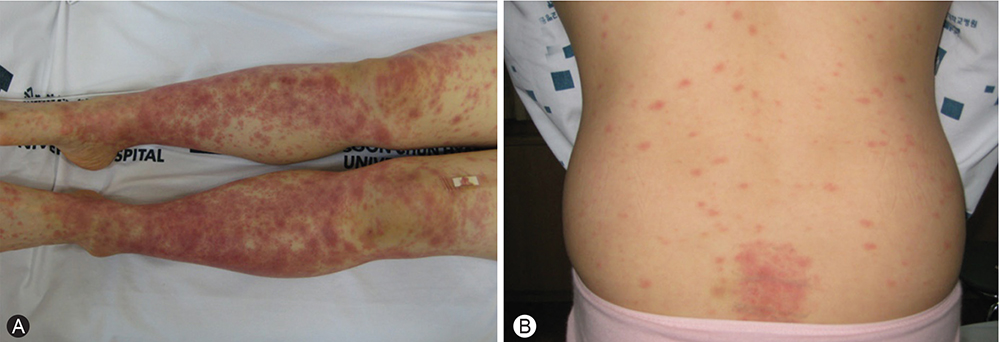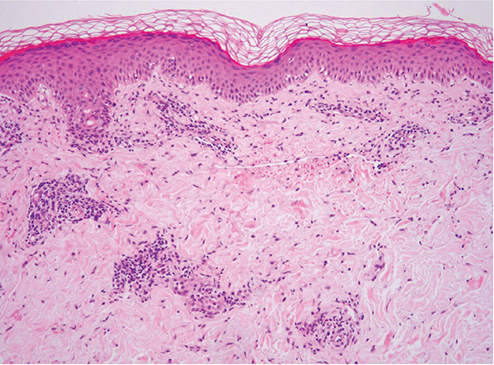Asia Pac Allergy.
2015 Oct;5(4):230-233. 10.5415/apallergy.2015.5.4.230.
Serum sickness reaction with skin involvement induced by bee venom injection therapy
- Affiliations
-
- 1Division of Respiratory-Allergy Medicine, Department of Internal Medicine, Soonchunhyang University Bucheon Hospital, Soonchunhyang University College of Medicine, Bucheon 14584, Korea. junehyuk@schmc.ac.kr
- KMID: 2397040
- DOI: http://doi.org/10.5415/apallergy.2015.5.4.230
Abstract
- Bee venom injection therapy is an alternative treatment sometimes used for chronic inflammatory diseases, including rheumatoid arthritis and multiple sclerosis, to reduce pain. Several chemical components of bee venom have anti-inflammatory effects, and apitoxin, one of the mixed components, has been used for pain prevention therapy. However, there have been no large-scale investigations regarding the efficacy or side effects or apitoxin. In this study, a case of serum sickness reaction that developed after receiving bee venom injection therapy is reported.
Keyword
Figure
Cited by 1 articles
-
Great learning, much networking, and friendship
Yoon-Seok Chang
Asia Pac Allergy. 2015;5(4):191-192. doi: 10.5415/apallergy.2015.5.4.191.
Reference
-
1. Lee MS, Pittler MH, Shin BC, Kong JC, Ernst E. Bee venom acupuncture formusculoskeletal pain: a review. J Pain. 2008; 9:289–297.2. Mirshafiey A. Venom therapy in multiple sclerosis. Neuropharmacology. 2007; 53:353–361.
Article3. Billingham ME, Morley J, Hanson JM, Shipolini RA, Vernon CA. Letter: Ananti-inflammatory peptide from bee venom. Nature. 1973; 245:163–164.4. Hartman DA, Tomchek LA, Lugay JR, Lewin AC, Chau TT, Carlson RP. Comparison ofantiinflammatory and antiallergic drugs in the melittin- and D49 PLA2-inducedmouse paw edema models. Agents Actions. 1991; 34:84–88.5. Koburova KL, Michailova SG, Shkenderov SV. Further investigation on theantiinflammatory properties of adolapin: bee venom polypeptide. Acta Physiol Pharmacol Bulg. 1985; 11:50–55.6. Reisman RE, Livingston A. Late-onset allergic reactions, including serumsickness, after insect stings. J Allergy Clin Immunol. 1989; 84:331–337.7. Stuhlmeier KM. Apis mellifera venom and melittin block neither NF-kappaB-p50-DNA interactions nor the activation of NF-kappa B, instead they activatethe transcription of proinflammatory genes and the release of reactive oxygenintermediates. J Immunol. 2007; 179:655–664.8. Kim SK, Park KY, Yoon WC, Park SH, Park KK, Yoo DH, Choe JY. Melittin enhancesapoptosis through suppression of IL-6/sIL-6R complex-induced NF-κB and STAT3activation and Bcl-2 expression for human fibroblast-like synoviocytes inrheumatoid arthritis. Joint Bone Spine. 2011; 78:471–477.9. Hong SJ, Rim GS, Yang HI, Yin CS, Koh HG, Jang MH, Kim CJ, Choe BK, Chung JH. Bee venom induces apoptosis through caspase-3 activation in synovial fibroblasts of patients with rheumatoid arthritis. Toxicon. 2005; 46:39–45.
Article10. Shkenderov S, Koburova K. Adolapin: a newly isolated analgetic andanti-inflammatory polypeptide from bee venom. Toxicon. 1982; 20:317–321.11. Jung JW, Jeon EJ, Kim JW, Choi JC, Shin JW, Kim JY, Park IW, Choi BW. A fatalcase of intravascular coagulation after bee sting acupuncture. Allergy Asthma Immunol Res. 2012; 4:107–109.
- Full Text Links
- Actions
-
Cited
- CITED
-
- Close
- Share
- Similar articles
-
- A Case of Serum Sickness Reaction Caused by Honeybee Acupuncture
- Two Cases of Serum Sickness Reaction Induced by Bee Stings
- A Case of Delayed Type Skin Reaction Induced by Bee Venom Acupuncture
- A case of angioedema associated with eosinophilia induced by bee sting
- Efficacy of Bee Venom Injection for Osteoarthritis Patients



